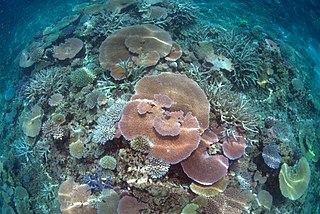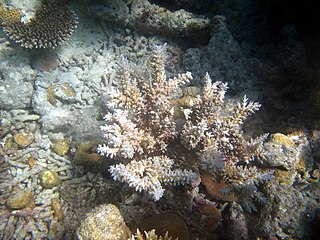
Acropora is a genus of small polyp stony coral in the phylum Cnidaria. Some of its species are known as table coral, elkhorn coral, and staghorn coral. Over 149 species are described. Acropora species are some of the major reef corals responsible for building the immense calcium carbonate substructure that supports the thin living skin of a reef.

The staghorn coral is a branching, stony coral with cylindrical branches ranging from a few centimetres to over two metres in length and height. It occurs in back reef and fore reef environments from 0 to 30 m depth. The upper limit is defined by wave forces, and the lower limit is controlled by suspended sediments and light availability. Fore reef zones at intermediate depths 5–25 m (16–82 ft) were formerly dominated by extensive single-species stands of staghorn coral until the mid-1980s. This coral exhibits the fastest growth of all known western Atlantic fringe corals, with branches increasing in length by 10–20 cm (3.9–7.9 in) per year. This has been one of the three most important Caribbean corals in terms of its contribution to reef growth and fishery habitat.

Acropora cytherea is a stony coral which forms horizontal table like structures. It occurs in the Indo-Pacific Ocean in areas with little wave action, favouring back reef environments from 3 to 20 m depth.

Acropora pulchra is a species of colonial staghorn coral in the family Acroporidae. It is found on the back fringes of reefs in shallow water in the western Indo-Pacific Ocean. The oldest fossils of this species date back to the Pleistocene.

Acropora hyacinthus is a species of Acropora described from a specimen collected in Fiji by James Dwight Dana in 1846. It is thought to have a range that includes the Indian Ocean, the Indo-Pacific waters, southeast Asia, Japan, the East China Sea and the western Pacific Ocean. It lives on shallow reefs on upper reef slopes, and is found from depths of 1–25 m. Crown-of-thorns starfish preferentially prey upon Acropora corals.
Acropora speciosa is a species of acroporid coral found in the Red Sea, the Gulf of Aden, the southwest and northern Indian Ocean, the central Indo-Pacific, Southeast Asia, Japan, the East China Sea, eastern Australia and the oceanic west and central Pacific Ocean. It occurs in shallow reefs at depths of 2 to 25 metres.

Acropora anthocercis is a species of acroporid coral that was first described by G. Brook in 1893. Found on the top slopes of reefs, it is often in contact with strong waves. The species is rated as vulnerable on the IUCN Red List, with a decreasing population covering a large range, but is abundant in some areas such as Queensland. It is also listed under CITES Appendix II.
Acropora batunai is a species of acroporid coral that was described by Carden Wallace in 1997. Found in protected, shallow reefs, it occurs in a marine environment at depths of up to 44 m (144 ft). The species is rated as vulnerable on the IUCN Red List, with a decreasing population, and is extremely fragile. It can be found over a large area but, overall, is not common.
Acropora derawanensis is a species of acroporid coral that was first described by Carden Wallace in 1997. Found in tropical, shallow reefs sheltered from the waves in a marine environment, it is found at depths of 10 to 25 m on reef slopes. The species is rated as vulnerable on the IUCN Red List, with a decreasing population. It is not common but found over a large area, and is listed on CITES Appendix II. It is easily damaged.
Acropora desalwii is a species of acroporid coral that was first described by Dr Carden Wallace in 1994. Found in sheltered, tropical, shallow reefs, mainly on the slopes, this species is generally found at depths below 15 metres, but this can be as low as 30 metres. The species is rated as vulnerable on the IUCN Red List, with a decreasing population, and is affected by disease. It is common and found over a large area, and is listed under CITES Appendix II.

Acropora donei is a species of acroporid coral that was first described by J. Veron and Carden Wallace in 1984. Found in fringing reefs and the upper slopes of shallow reefs, it occurs at depths of 5 to 20 m. The species is rated as vulnerable on the IUCN Red List, with a decreasing population, and is affected by disease. It is not common but found over a large area, and is listed under CITES Appendix II.

Acropora echinata is a species of acroporid coral that was first described by Dana in 1846. Found in shallow, tropical, sheltered reefs in marine environments, it is found at depths of 8 to 25 m in clear water. The species is listed as vulnerable on the IUCN Red List, and has a decreasing population. It is not common but found over a large area, and is listed under CITES Appendix II.

Acropora horrida is a species of acroporid coral that was first described by James Dwight Dana in 1846. Found in tropical, shallow reefs in marine environments, it occurs near fringing reefs around turbid water, at depths of 5 to 20 m. It is listed as a vulnerable species on the IUCN Red List, and it is thought to have a decreasing population. It is not common and found over a large area, and is listed under CITES Appendix II.
Acropora kosurini is a species of acroporid coral that was first described by C. C. Wallace in 1994. Found in marine, shallow reefs, it occurs at depths of 8 to 20 m. It is listed as a vulnerable species on the IUCN Red List, and it is believed to have a decreasing population. It is rare but found over a large area, and is listed on CITES Appendix II.
Acropora loisetteae is a species of acroporid coral that was first described by C. C. Wallace in 1994. Found in marine, tropical, shallow reefs in sheltered lagoons, it is found at depths between 1 and 30 m. It is listed as vulnerable on the IUCN Red List, and it is thought to have a decreasing population. It is not common but found over a large area, and is listed under CITES Appendix II.
Acropora lokani is a species of acroporid coral that was first described by C. C. Wallace in 1994. Found in marine, shallow reefs and sheltered lagoons, it occurs at depths between 8 and 25 m. It is listed as vulnerable on the IUCN Red List, and is believed to have a decreasing population. It is not common but found over a large area, including in three regions of Indonedia, and is listed under CITES Appendix II.

Acropora microclados is a species of acroporid coral that was first described by Christian Gottfried Ehrenberg in 1834. Found in marine, tropical shallow reefs on the upper slopes, it is found at depths of 5 to 20 m. It is listed as a vulnerable species on the IUCN Red List, and its population is decreasing. It is uncommon but found over a large area, including in five regions of Indonesia, and is classified under CITES Appendix II.
Acropora multiacuta is a species of acroporid coral that was first described by F. Nemenzo in 1967. Found in marine, tropical shallow reefs in lagoons, on rocks or on the tops of reefs, it occurs at depths between 3 and 15 m. It is classed as a vulnerable species on the IUCN Red List, and it has a decreasing population. It is uncommon but found over a large area, including in two regions of Indonesia and the Great Barrier Reef, and is classified under CITES Appendix II.
Acropora pharaonis is a species of acroporid coral that was first described by Milne-Edwards and Haime in 1860. Found in marine, tropical, reefs on slopes sheltered from wave action, it occurs at depths of between 5 and 25 m. It is classed as a vulnerable species on the IUCN Red List, and it has a decreasing population. It is common and found over a large area and is classified under CITES Appendix II.

Acropora polystoma is a species of acroporid coral that was first described by G. Brook in 1891. Found in marine, tropical, reefs on upper slopes where waves are strong, it occurs at depths between 3 and 10 m. It is classed as a vulnerable species on the IUCN Red List, and it has a decreasing population. It is not common and found over a large area and is classified under CITES Appendix II.












